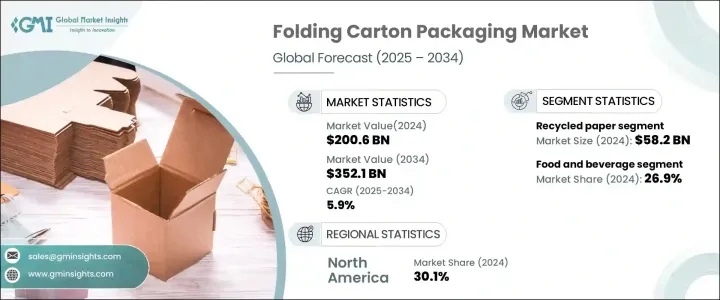
세계의 접이식 상자 포장 시장은 2024년 2,006억 달러로 평가되었으며, 2025년부터 2034년까지 연평균 복합 성장률(CAGR) 5.9%를 나타낼 것으로 예상됩니다.
이 성장의 주요 요인은 식품 및 음료 업계 수요 증가와 지속 가능한 포장 솔루션의 중요성을 높이는 것입니다. 가 있고 보호성이 높은 접이식 상자 포장의 필요성을 부추기고 있습니다. 제조업체 각사는 규제 가이드라인과 친환경 솔루션을 요구하는 소비자의 기호의 진화에 대응하기 위해 종이 기반의 상자로 이동하고 있습니다.

게다가 일회용 플라스틱에 대한 엄격한 규제와 지속 가능한 대체품을 추진하는 정부의 대처에 의해 재활용 가능한 소재나 생분해성 소재의 채용이 가속하고 있습니다. 신속한 확대가 시장 성장에 더욱 기여하고 있습니다. 온라인 소매업체는 운송 중 제품의 안전성을 확보하면서 고객 경험을 향상시키는 경량으로 안전한 포장을 선호합니다.
| 시장 범위 | |
|---|---|
| 시작 연도 | 2024년 |
| 예측 연도 | 2025-2034년 |
| 시작 금액 | 2,006억 달러 |
| 예측 금액 | 3,521억 달러 |
| CAGR | 5.9% |
이 시장은 재활용지, 크래프트지, 플라스틱, 버진지, 기타 소재 등 소재의 유형에 따라 분류됩니다.
용도별로는 시장은 식음료, 가정용품, 퍼스널케어 및 화장품, 헬스케어 및 의약품, 일렉트로닉스, 기타 분야로 구분됩니다. 이 제품은 지속적으로 재활용 가능한 소재에 대한 수요가 증가함에 따라 편의식품과 이동 중에 소비를 위한 소비자 행동의 변화는 휴대가 가능하고 안전한 포장 솔루션의 필요성을 더욱 높여줍니다.
지역별로는 북미가 2024년 접이식 상자 포장 시장 점유율의 30.1%를 차지했으며, 환경 친화적인 포장 재료에 대한 정부의 강력한 지원과 일회용 플라스틱의 금지가 그 원동력이 되고 있습니다. 미국은 전자상거래의 급속한 확대와 지속가능성에 대한 규제의 관심이 높아짐에 따라 530억 달러의 수익을 올렸습니다.
The Global Folding Carton Packaging Market was valued at USD 200.6 billion in 2024 and is projected to grow at a CAGR of 5.9% from 2025 to 2034. This growth is primarily driven by increasing demand from the food and beverage industry and a growing emphasis on sustainable packaging solutions. Consumers are increasingly opting for frozen foods, ready-to-eat meals, and convenient snack options, fueling the need for durable and protective folding carton packaging. Manufacturers are shifting toward paper-based cartons to meet regulatory guidelines and evolving consumer preferences for eco-friendly solutions.

Additionally, stringent regulations against single-use plastics and government initiatives promoting sustainable alternatives have accelerated the adoption of recyclable and biodegradable materials. With businesses investing in sustainable packaging to comply with policies and cater to environmentally conscious consumers, the industry is witnessing a surge in demand for innovative and functional folding cartons. Meanwhile, the rapid expansion of e-commerce has further contributed to market growth. Online retailers prefer lightweight and secure packaging that enhances the customer experience while ensuring product safety during transit. The integration of digital printing and smart labels has also gained traction, allowing brands to improve engagement and appeal to modern consumers through visually enhanced packaging.
| Market Scope | |
|---|---|
| Start Year | 2024 |
| Forecast Year | 2025-2034 |
| Start Value | $200.6 Billion |
| Forecast Value | $352.1 Billion |
| CAGR | 5.9% |
The market is categorized based on material type, including recycled paper, kraft paper, plastic, virgin paper, and other materials. Among these, recycled paper accounted for USD 58.2 billion in 2024, driven by strict regulations on plastic usage and a rising consumer inclination toward sustainable options. Industries are widely adopting recycled paper cartons as a cost-effective solution that aligns with eco-friendly packaging mandates.
In terms of application, the market is segmented into food and beverages, household products, personal care and cosmetics, healthcare and pharmaceuticals, electronics, and other sectors. The food and beverage segment dominated in 2024, capturing 26.9% of the total market share. This growth stems from an increasing demand for sustainable and recyclable materials as brands continue to transition toward biodegradable paper-based packaging. The shift in consumer behavior toward convenience foods and on-the-go consumption has further propelled the need for portable and secure packaging solutions.
Regionally, North America accounted for 30.1% of the folding carton packaging market share in 2024, driven by strong governmental support for eco-friendly packaging materials and the ban on single-use plastics. The U.S. led the regional market, generating USD 53 billion in revenue, primarily due to the rapid expansion of e-commerce and growing regulatory focus on sustainability. Companies are increasingly embracing folding cartons for their environmentally friendly attributes and protective benefits during transportation and storage.